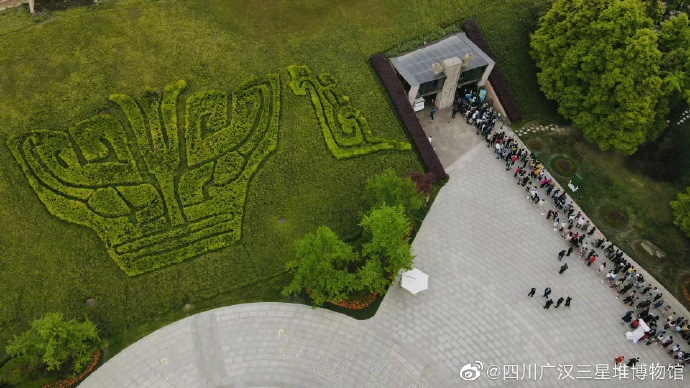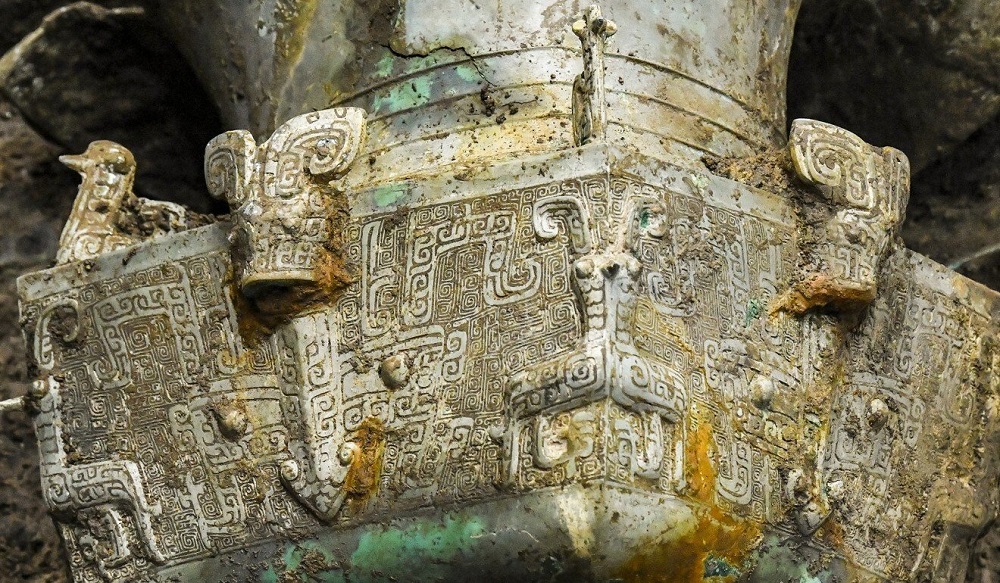Written by: Mahnoor Fatima
Posted on: April 07, 2021 |  | 中文
| 中文
The Recently Unearthed Gold Mask
It is rare for an artefact to cause such a commotion, that too during the middle of a pandemic. But for the researchers at Sanxingdui Museum and Archaeological Ruins, and the Chinese people, the recent excavation of an ancient mask and other such relics has caused a sensation. These new discoveries have once more piqued public attention about the enigmatic ruins of Sanxingdui and its creators.
The Sanxingdui ruins are located in Guanghan, southwest of China's Sichuan province. The archaeological site itself has relics that are over 5000 years old, and is dubbed “the origin of civilization at the Yangtze River.” It is the largest museum in Southwest China, and the exhibits include bronze masks, gold objects, and jade articles. Over the Qingming Festival weekend, about 20,000 visitors came to the museum in a single day, breaking all previous records.

Visitors line up before entering the Sanxingdui Museum in Guanghan, southwest China's Sichuan Province (Credits to Sanxingdui Museum)
Sanxingdui Ruins, however, are considered to be one of China’s most fascinating mysteries. The name means “Three Star Mounds”, indicating three large mounds of earth at the site, which archaeologists believe were the remains of an earth and brick wall. Evidence and relics point to the existence of an unknown city and civilization that existed simultaneously with the Chinese Bronze Age Shang Dynasty period (1600–1046 BC).
Since this civilization, which researchers call ‘Shu Dynasty’, kept very few written records of its customs and practices, any new evidence which indicates the civilization’s way of life, is an important discovery. However, its existence is notable because it rejects the previously conceived idea that the origins of Chinese civilization occurred only on the lower reaches of the Yangtze river. This seems to have been a civilization located in the South, which existed independently of neighboring societies in the river valley. These mounds, in particular, were thought to be sacrificial burial mounds, which is why important objects were buried in them.

A bronze item recently unearthed from a sacrificial pit at the Sanxingdui archaeological site. (Credits to Li He_Xinhua_Sipa USA)
Although excavations have been taking place at the ruins since 1934, the last extensive dig of the site occurred 35 years ago. During the 37th excavation in late March, 500 artefacts that are over 3000 years old, have been unearthed in six recently dug mounds. These include the now-famous ceremonial half-mask made out of pure gold, along with bird-shaped ornaments, bronze head portraits, sacred tree statutes, ivories, tooth carvings and jade tools. While people flocked to the museum hoping to get a chance to see these relics, the new pits and artefacts are still undergoing restoration and are not yet available to the public.
The most groundbreaking and puzzling aspects of these discoveries are that the symbols and designs on the artefacts are not traditionally Chinese in character, and instead allude to integrated and diverse connections with the outside world. While some handicrafts display traditional Chinese ‘Zun’ and ‘Lei’ vessel designs, other relics have similarities with those found in West, Central and Southeast Asia. Archaeologists have also found thousands of seashells, which they believe came from India and other coastal regions through maritime routes.
The diversity and international linkages between artefacts found in the ruins and other places, is enough evidence for researchers to believe that broad exchanges took place in ancient times. Such an idea runs counter to the claim that the Shu were considered an advanced civilization while the rest of the world were ‘barbarians’. Instead, it suggests that the story of Chinese civilization has been complex, diverse and inclusive since ancient times.
In addition, archaeologists have also found silk materials in the area, suggesting that the production of silk in China may be older than once believed. The discovery of 2000-year-old silk also suggests that Sanxingdui may have once been a hub for trade on the ancient Silk Road, and silk production in China itself. Upon the discovery of these new artefacts, the deputy director of the National Cultural Heritage Administration, Song Xinchao, expressed to state-run press agency Xinhua that the latest finds "enrich and deepen our understanding of the Sanxingdui culture.”
While Sanxingdui is not yet recognized as a UNESCO World Heritage Site, the ruins remain on a tentative list for future inclusion. Indeed, with each new excavation, a new artefact has the potential to completely alter perceptions about the origins of Chinese culture. It is fascinating to think that even across vast distances in ancient times, civilizations continued to integrate and exchange goods with one another, and that China’s willingness to trade and learn from other cultures has been part of its historical fabric since ancient history.
You may also like: